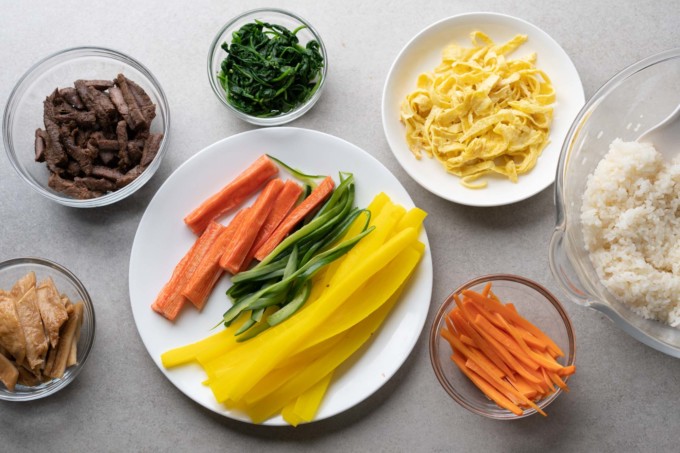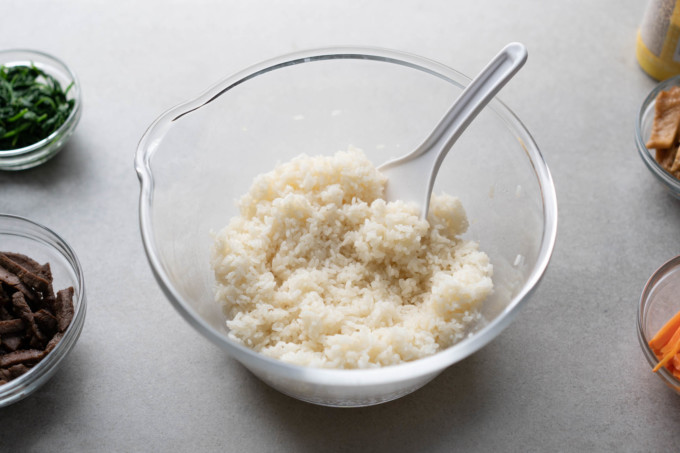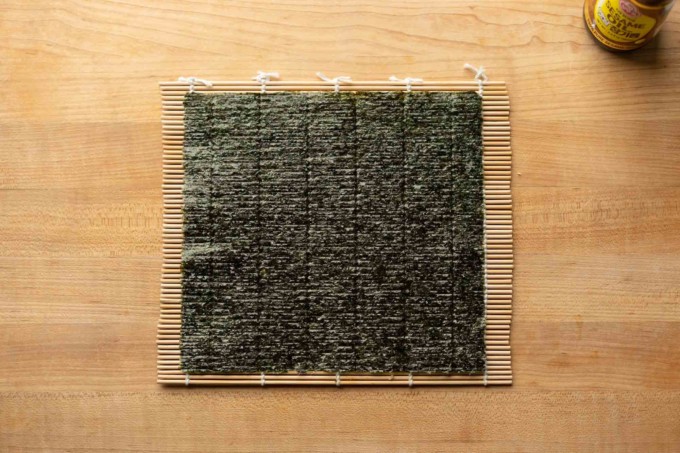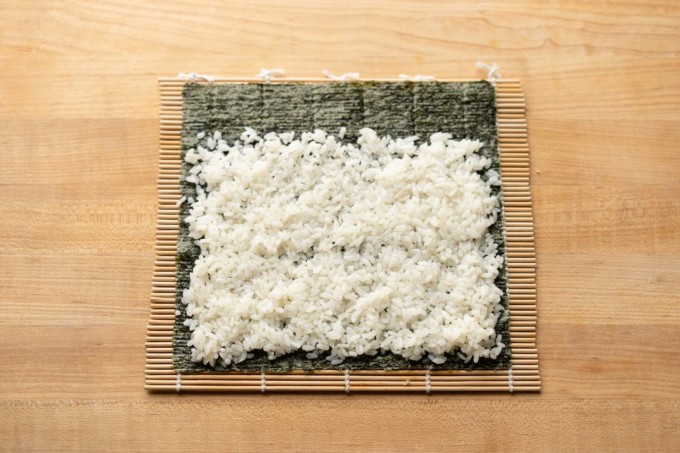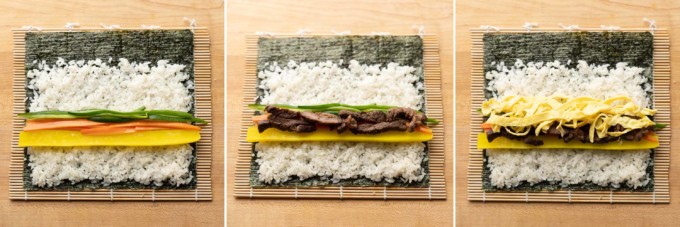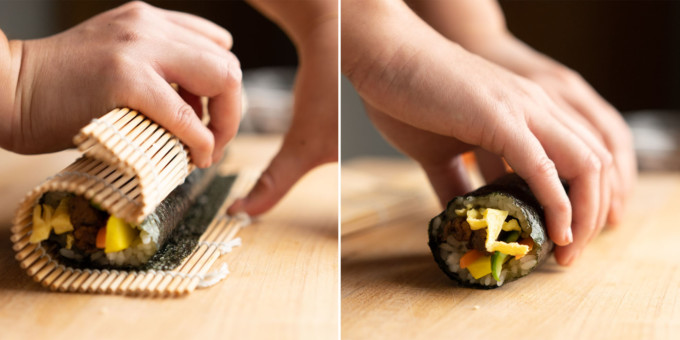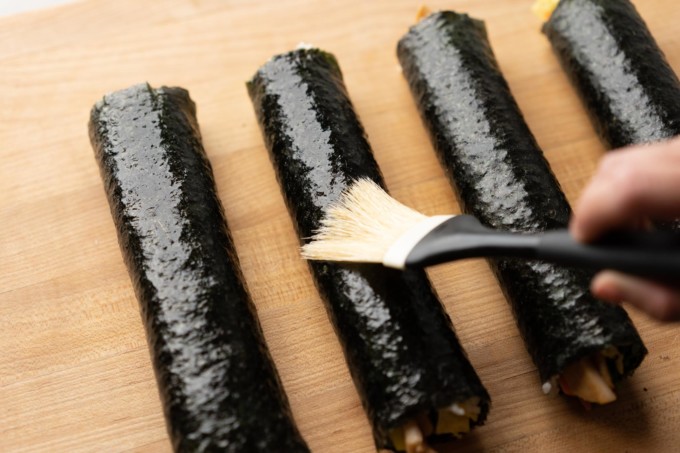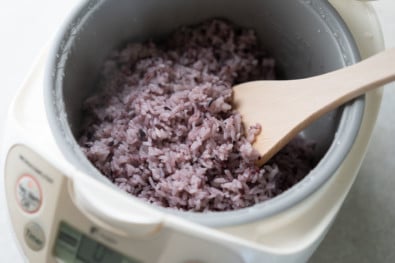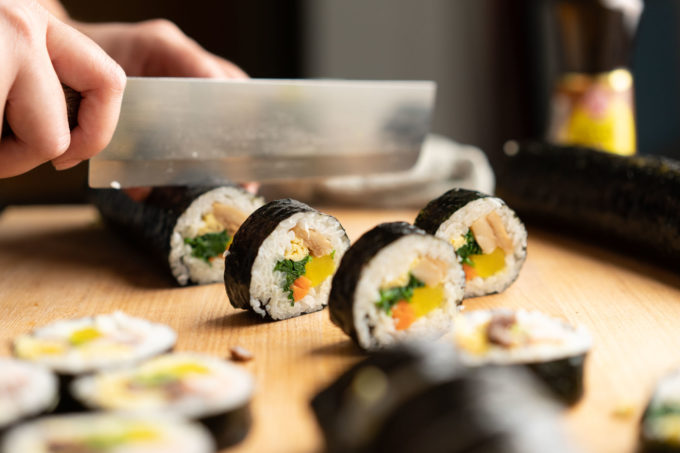
This Kimbap, or Korean rice rolls, recipe is one of my favorite Korean snacks. It looks like a sushi cut roll but instead of just fish inside, it’s traditionally meant to be customizable based on whatever you have on hand or want to eat.
You will most often see fillings for kimbap like crunchy yellow pickled radish, fresh cucumbers, sweet carrots, fried fish cake or savory beef, and more all wrapped in seaweed and nutty sesame seasoned rice.
What is kimbap?
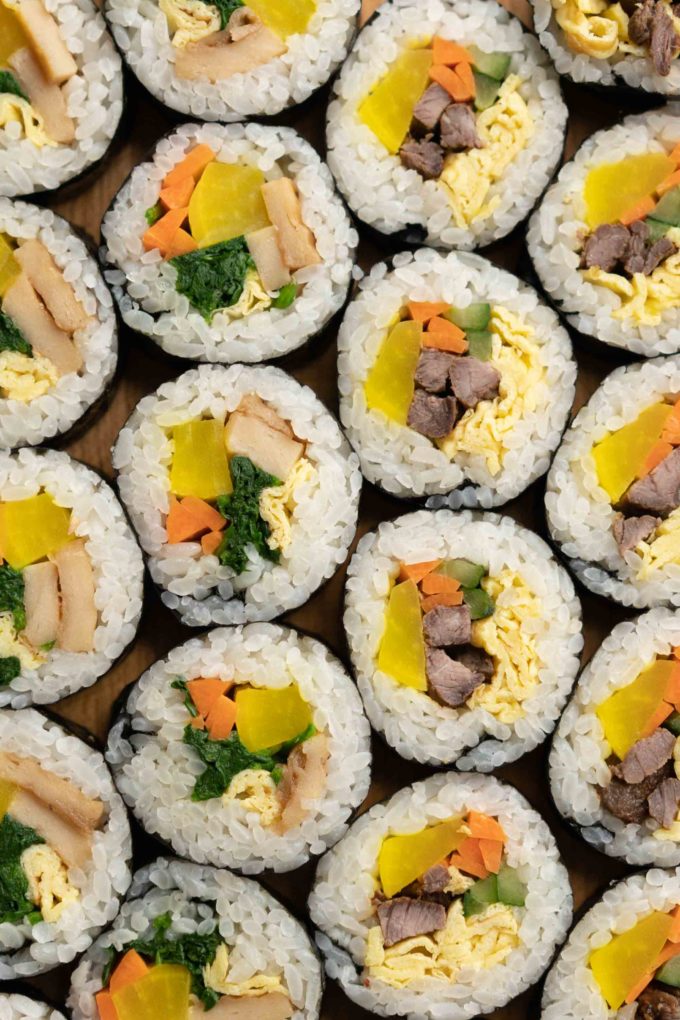
Kimbap is the romanized name for gimbap, which translates to seaweed (gim) rice (bap) in Korean. Simply put, it’s a seaweed-wrapped rice roll filled with a variety of fixings like yellow pickled radish, spinach, cucumbers, eggs, and different proteins.
While there are a couple of theories of how kimbap came to be, like the Japanese influence of makizushi in Korea during the Japanese occupation in the early 1900s, the Encyclopedia of Korean Culture states that wrapping banchan in rice and seaweed was a constant in Korean culture since the Joseon Era (1392-1910).
Kimbap rice
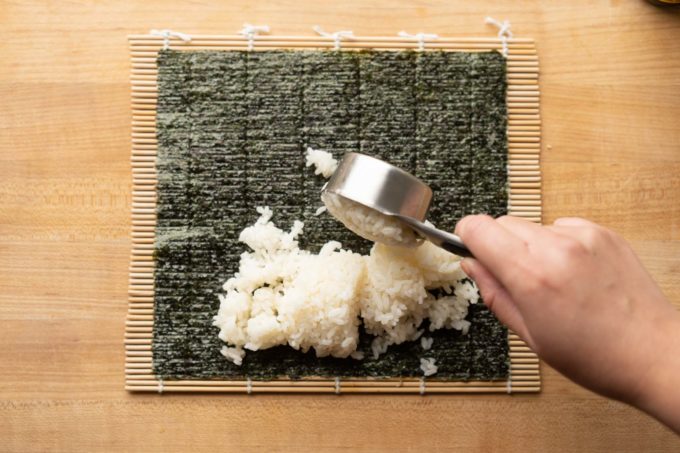
Can you use regular rice for kimbap? If you use long grain or jasmine rice for your regular rice consumption, I would say no. Since long-grain or jasmine rice is less sticky, it will be hard for kimbap to keep its round shape, especially after cutting into slices. You can also use Korean purple rice, too, since it’s got a sticky consistency.
If you want your kimbap to keep its structure and stick together, make sure to use short-grain white rice. This is the same variety as sushi rice and just like other rolls (spicy tuna rolls or California rolls), short-grain rice has the best plump texture and strong glue-like consistency to keep all the fillings inside the seaweed wrapper. You can also use medium-grain rice, since it still has a sticky consistency, too.
My favorite brands of short-grain rice to buy are Tamaki Gold short-grain rice, Koda Farms Kokuho Rice (medium grain), and Koshihikari short-grain rice. You can find these at your local Asian grocery stores like H-Mart, 99 Ranch, or Mitsuwa.
Choosing seaweed for kimbap

When picking seaweed for kimbap, you want to pick the dried and roasted seaweed sheets at your local Korean grocery store. There are different types of Korean roasted seaweed sheets available, so make sure to buy the full-sized sheets (about 8×9 inches in size) that are unseasoned. You can also use Japanese roasted seaweed, aka nori, since these are more widely available at American grocery stores these days and there is not much difference between the two.
Kimbap ingredients and filling ideas
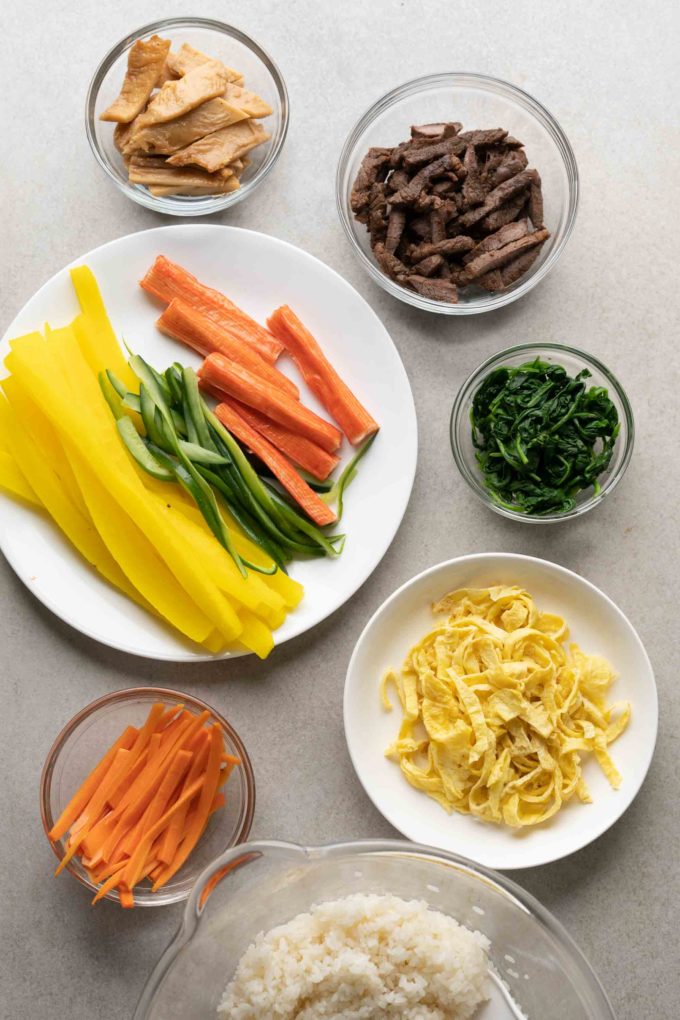
What makes kimbap so versatile is that you can add any fillings you want based on what you have at hand. There’s beef kimbap, tuna kimbap, and more! Here are some ideas for what to put in kimbap. I usually like to pick one protein, pickles, and two or three vegetables.:
- Yellow pickled radish (or danmuji): this is an essential staple in kimbap
- Vegetables: cucumbers, carrots, blanched spinach
- Meat: bulgogi, skirt steak, short rib, ham, or other types of already cooked meats
- Other protein: eggs, spam, tuna, fish cake, kani (imitation crab)
Tips for rolling kimbap
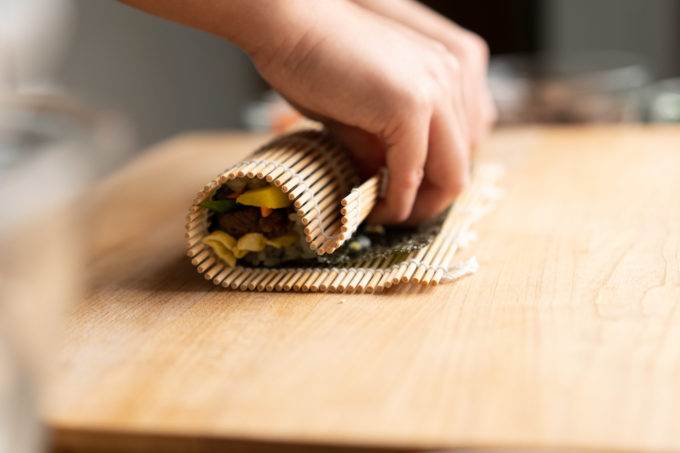
We get it, rolling anything in gim (or nori) in rice can be a bit challenging. Here is a guide to rolling kimbap:
- Use a rolling mat! This helps you guide the gim and roll it easily to make your kimbap.
- Place the gim (or nori) shiny side down. The other side of the gim will have a scratchy texture that helps the rice stick.
- Use about ¾ cup of cooked rice and add some sesame oil to your hands to help spread and even out the rice on the gim. I like to leave about one inch of seaweed at the top of the gim to help with rolling at the end. This distance you leave will increase if you have fewer ingredients or less rice. Just roll one first then adjust the rice level or amount to accommodate on your next ones.
- Fill your kimbap without getting too greedy: Don’t add too much filling, otherwise, it will be hard to roll. Try to place the flattest and least bulky ingredients on the rice first–this will help with stacking and rolling the kimbap. For example, add the yellow pickled radish, then carrots, cucumbers, egg, and fishcake horizontally on the center of the rice. It’s okay if ingredients go past the sides of the gim. Then stack the bulkier items like spinach, meat, or kani on top of the other ingredients. It should look like a mound in the middle of your rice.
- Start rolling from the bottom, upwards. Use your thumbs and point fingers to lift the bottom of the gim and rolling mat up and over the mound of filling. You’ll need to use your fingers to keep all the fillings in place as you roll the sheet over and try to keep everything tight.
- Keep it tight. Make sure the bottom edge of the gim completely covers the filling and rice and makes contact with the other side of the gim. You should have a log shape now.
- Shape and tighten the roll. Take your left hand and place it on the top center of the rolling mat, and gently push the mat upwards while simultaneously using your right hand to squeeze the log downwards–this helps tighten the roll.
- Finish rolling. Release your left hand and take the bottom edge of the rolling mat and move in an upwards motion so you continue rolling the gim and roll upwards to form the kimbap. Set the kimbap with the seam side down so it can seal itself as it sits on the plate.
What’s the difference between kimbap and gimbap?
Kimbap is the romanized version of gimbap, and both translate to seaweed rice. Kimbap and gimbap can be used interchangeably.
Why is kimbap not sushi?

Kimbap and sushi are two different dishes. While they both are seaweed and rice-wrapped rolls with custom fillings rolled in the same way as sushi–that’s where the similarities end. Where sushi rice is typically seasoned with sugar, salt, and vinegar, kimbap rice has sesame oil and salt.
Sushi is filled with raw or cooked fish, and in contrast, kimbap has a mix of vegetables and proteins like yellow pickled radish, spinach, eggs, beef, fishcake, and more.
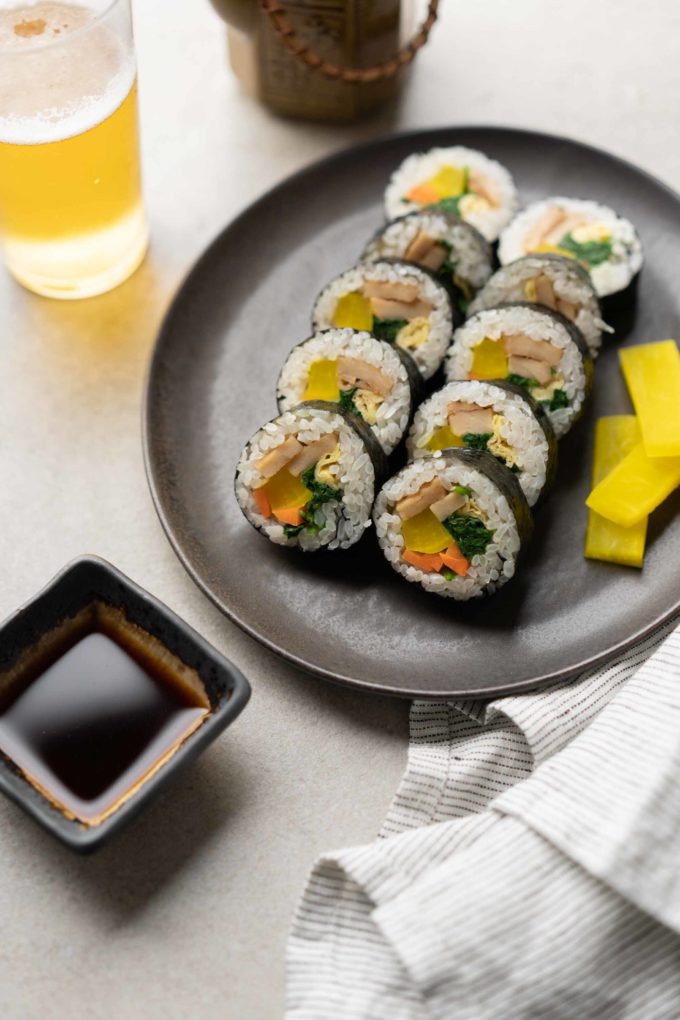
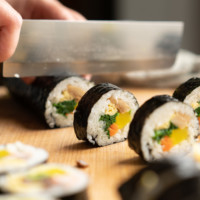
Kimbap (Korean Seaweed & Rice ‘Sushi’ Rolls)
Ingredients
Meat
- ½ lb boneless short rib, or skirt steak also optional to use beef or pork bulgogi or fish cake as the main protein
- 1 tbsp soy sauce
- 1 tsp rice vinegar
- ¼ tsp garlic powder
- ¼ tsp cane sugar
- ¼ tsp black pepper
Veggie option A: Cucumber
- 1 medium Persian cucumber julienned
- ½ tsp kosher salt
Veggie Option B: Spinach
- 4 c spinach packed
- 6 c filtered water plus more for ice bath
- 2 c ice
- ½ tsp sesame oil
- ¼ tsp kosher salt
Carrot
- 1 medium carrot peeled and julienned
- ¼ tsp neutral oil
Eggs
- 2 large eggs beaten
- ¼ tsp kosher salt
- 1 tsp neutral oil
Other fillings
- 1 yellow pickled radish ⅛” x ⅛” x 8” long slices
- kani sticks imitation crab
- fish cake cut into ¼ inch slices
Assembly
- 2 c short-grain rice cooked
- 1½ tsp sesame oil
- ½ tsp kosher salt
- 4 sheets gim or nori
- sesame seeds optional topping
Equipment Used
- knife and cutting board
- saute pan
- Pot
- Strainer
- tongs
- paddle
- brush
Instructions
Prep
- Meat: Slice meat into strips and add all the marinating ingredients to a bowl. Combine until thoroughly mixed and cover with a lid. Marinate on the counter while prepping other fillings (or about 15 minutes). After marinating, heat a pan over medium heat on the stove. Add one tablespoon of neutral oil to the pan and cook the meat until it browns and the internal temperature is 140 °F. Remove from the pan and place on a plate.
- Veggies: Choose either cucumbers or spinach. Cucumbers are recommended during the summer or if you will be taking kimbap to-go since they will last longer. You can also do 50/50! If you plan on using both, halve the recipe ingredients for both above.Cucumbers: Slice cucumbers into thin strips and place them in a bowl. Sprinkle the salt over the cucumbers and let sit for 10 minutes, or while you work on other ingredients. After 10 minutes, gently squeeze the excess water out of the cucumbers as much as possible. Place the cucumbers on a plate. Spinach: In a pot, add the filtered water and bring to a boil. Blanch the spinach for one minute and transfer it to an iced bath for two minutes. Gently squeeze the excess water over the sink and place it in a bowl. Add 1/8 teaspoon salt and ¼ teaspoon sesame oil. Mix until it’s combined and set aside.
- Carrot: Peel the carrot and julienne into thin slices. Heat the pan on medium-low and add ¼ teaspoon of neutral oil. Add the slices of carrots and saute for only 30 seconds to one minute. Remove when they are slightly limp and place on a plate.
- Eggs: Beat eggs in a bowl and sprinkle the salt. On the same pan, add another teaspoon of neutral oil and add half of the beaten eggs. Swirl the eggs around to make one thin, circular omelet. Cook for 30 seconds or until it’s opaque and flip to cook the other side until it’s firm. Remove the omelet and cook the rest of the beaten egg mixture. Cut the eggs into ½ inch wide strips.
- Yellow pickled radish: Cut the pickled radish into ⅛” x ⅛” x 8” long slices and set aside.
- Fish cake: Cut fish cake into ¼ inch thick slices and set aside.
- Kani: Defrost the kani on the counter for about 30 minutes. Unpeel the kani from the wrappers and place them on a plate.
- Rice: Remove the freshly cooked rice from the cooker into a bowl. Add the sesame oil and salt. Use a rice paddle to gently mix together the ingredients.
Assembly
- Place a gim or nori sheet on the sushi mat with the shiny side face down. The gim should be positioned so that the longest side is horizontal to your body.
- Add ¾ cup of rice onto the gim. TIP: add a little bit of sesame oil on your hands to make it easier to spread the rice. Spread the rice from the bottom to the top and leave about one inch of space at the top of the nori.
- Begin to add the ingredients in an even line horizontally in the center of the gim and rice. Tips: add the flat pieces first, like the pickled radish, cucumbers, carrots, fish cake, or eggs on the bottom layer so they can act as a flat surface for the other ingredients. Then add the kani, spinach, and/or meat on top. Try not to add too many ingredients or it will be difficult to roll. You want to add just enough fillings so that the rice will cover all the fillings when it’s rolled.
- When you’re done filling, take the bottom of the rolling mat and the gim with your thumbs and pointer fingers. Lift them up to cover the roll upwards and use the rest of your fingers to hold the fillings in place; This should now have a log shape.
- Take your left hand and place it on the top of the rolling mat while holding onto the log with your right hand. Gently tug the top mat, and push down with your right hand to tighten the log. Continue to roll upwards until you have a log. It’s okay if you have extra nori at the end, just sit the log on its seam and it should seal after a minute. Make your next rolls.
- Once you have finished all the rolls, brush some sesame oil on the skin of the gim for a slight gloss and some flavor.
- Take a knife and cut the kimbap into ½ slices and serve.

